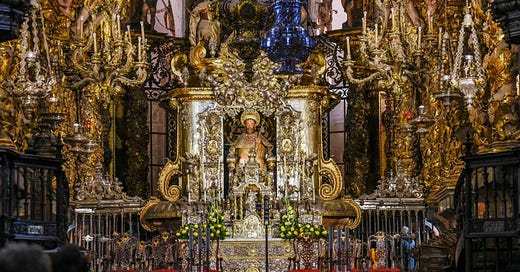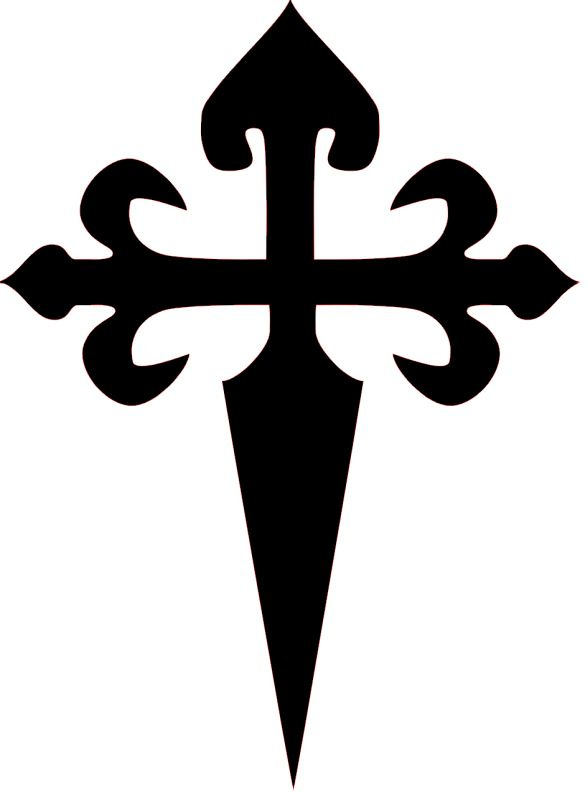St. James was the son of Zebedee, a Galilean fisherman, and Salome, a pious woman who tended after Christ. He and his younger brother, St. John (our Patron Saint) (Feast Day: December 27), were called as disciples just after Simon Peter and Andrew were called, and Peter, James and John are often mentioned together in Scripture, having been witness to the raising of Jairus's daughter, the Transfiguration, and Christ's Agony in the garden of Gethsemani.
James and his brother must have been been zealous and of a passionate nature as they came to be called "Boanerges" ("Sons of Thunder") -- a nickname given to them by Jesus Himself. After Our Lord's Ascension, tradition says that St. James's zeal for evangelizing took him to parts of Spain for a time -- where St. Paul had wanted to travel (Romans 15:24) -- whereafter he returned to Judea for his martyrdom.
In A.D. 44, Herod Agrippa I, the grandson of Herod the Great who tried to have Baby Jesus killed, set out to do the will of the Jews by dealing harshly with local Christians. St. James was accused, and Herod then "killed James, the brother of John, with the sword." (Acts 12:1-2). Church Historian, Eusebius, tells us that St. James's accuser followed James to martyrdom when he converted after hearing the Saint's confession to Herod. At the place where James was said to have been martyred by beheading, a chapel was built; you can find it near the sanctuary of Jerusalem's Cathedral of Saint James, in the Armenian Quarter.
Here tradition picks up again by telling us that James's relics were translated to Spain (of course, legends grew surrounding the event, one strange and lovely one in particular apparently meant to explain why the cockleshell is St. James's emblem. It is said that when the Saint's relics were being conveyed by ship from Jerusalem and approached the coast of Portugal, a man happened to be riding his horse on the beach. The horse disobediently plunged into the sea, with its rider, making for the boat. They sank, of course, but then rose again, covered with scallop shells, and hence the cockleshell became the symbol of our hero). The relics were entombed and rather forgotten after years of Roman persecution, Vandal and Visigoth invasions, and Muslim attacks -- forgotten, that is, until an early 9th century hermit named Pelayo discovered the tomb -- some say after seeing a star marking the place -- in an area that became known as Compostela, which means "Field of Stars." The King built a cathedral to mark the location (Pelayo's Bishop, Theodomor of Iria, is also buried there, refusing to be buried in his See out of his desire to be near the Saint).
The faithful began to make pilgrimages to the site -- so much so that Compostela became the third greatest place of pilgrimage, just after Jerusalem and Rome -- and still make the pilgrimage today. After making one of the many routes, known as "the Camino de Santiago," pilgrims attach cockleshells or their facsimile to their hats or clothes as "pilgrim badges," signs that they'd venerated the holy relics. Any year in which St. James's Day falls on a Sunday is called a Holy Year, and a plenary indulgence may be gained by making the pilgrimage (his Feast falls on a Sunday every 6, 5, 6, and 11 years). To gain the indulgence, one must fulfill the usual conditions of plenary indulgences, must intend the pilgrimage for spiritual purposes and must have made the last 63 miles (100 km) on foot or on horse, or the last 125 miles (200 km) on bicycle.
At the time of the Muslim ("Moorish") invasions mentioned above, a particular battle took place that was to seal St. James ever more closely to Spain, where he is known as "San Tiago." At the Battle of Clavijo in A.D. 841, the Christians had lost and were in retreat when King Ramirez of Leon had a dream in which the Apostle assured him of victory. He relayed his vision to his men, and the next morning he had his trumpeters sound the call to battle. There, on the field, the men saw St. James on a horse adorned with cockleshells, waving a banner. He led the Christians on to a clear victory, and ever since, the Spanish battle-cry has been "Santiago!" and St. James has been known as "Matamoros" -- "Moor-slayer."
St. James is Patron of the Spanish people, equestrians, blacksmiths, tanners, and veterinarians. He is usually depicted in art with his symbols -- the cockleshell, pilgrim hat, sword, Sacred Scripture -- or on horeseback, usually trampling a Moor.1
As to the day's customs, because of the love the Spanish have for St. James, they adopted him as their Patron, and his Feast is a national holiday, a time of great celebration, much like the Feast of St. Patrick is for the Irish, that of St. Joseph is for the Italians, that of St. George is for the English, and that of St. Andrew is for the Scots. In Compostela, there are great processions and the famous La Fachada fireworks display.
And at the city's cathedral, the city's faithful father to worship -- and many pilgrims, too, especially when his feast falls on a Sunday. From the ceiling of this great cathedral hangs a six-foot tall 14th century censer (the "botafumeiro") that is swung by pulleys on this day and for a few other great Feasts. The censer is so large that it takes eight people to swing it properly! A hymn you might hear in Compostela on the Feast of St. James:
The food du jour in Spain at this time is a lemon and almond-flavored St. James Cake. To make it, you'll need to make a cardboard stencil out of this image of the St. James Cross (right-click and save the image, print it, tape the paper at its edges on to a piece of cardbard, and cut the image out so you're left with a cardboard stencil):
Tarta de Santiago
2 2/3 cups almonds
4 large eggs
1 1/4 cups granulated sugar
1/2 cup unsalted butter, at room temperature
3/4 cup flour
1/2 teaspoon baking powder
1/2 cup water
zest from 1 lemon
powdered sugar for garnish
Blanch the almonds, then using a grinder or a food processor, grind the almonds until fine and set aside.
Heat the oven to 350 F. Grease a 8-inch round cake pan, and butter its sides.
Beat the eggs and sugar together. Add the butter, flour, baking powder, and water and beat until well combined. Stir the ground almonds into the batter. Add the lemon zest and stir until thoroughly mixed.
Pour batter into prepared cake pan. Bake in the oven on the middle shelf for approximately 45 to 50 minutes, until it tests done when a toothpick stuck in the middle comes out clean. Let it cool about 15 minutes, then remove the cake from the pan and lay your St. James Cross stencil on top and dust with powdered sugar. Carefully remove the stencil.
https://fisheaters.com/customstimeafterpentecost4x.html





